#historical paiting
Photo
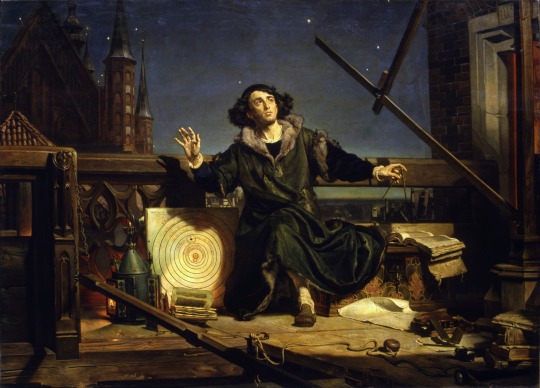
Astronomer Copernicus or Conversations with God (1872) by Jan Matejko.
Jan Matejko (1838-1893) was a Polish painter, known for depicting important events and figures from Polish history. He spent most of his life in Krakow.
The original painting can be found in Collegium Novum Assembly Hall of Jagiellonian University. Mikołaj Kopernik / Nicolaus Copernicus is one of its famous students.
#poland#cracow#kraków#krakow#polish art#polish painting#historical paiting#fine arts#jan matejko#copernicus#kopernik był kobietą#jagiellonian university#uj
16 notes
·
View notes
Text
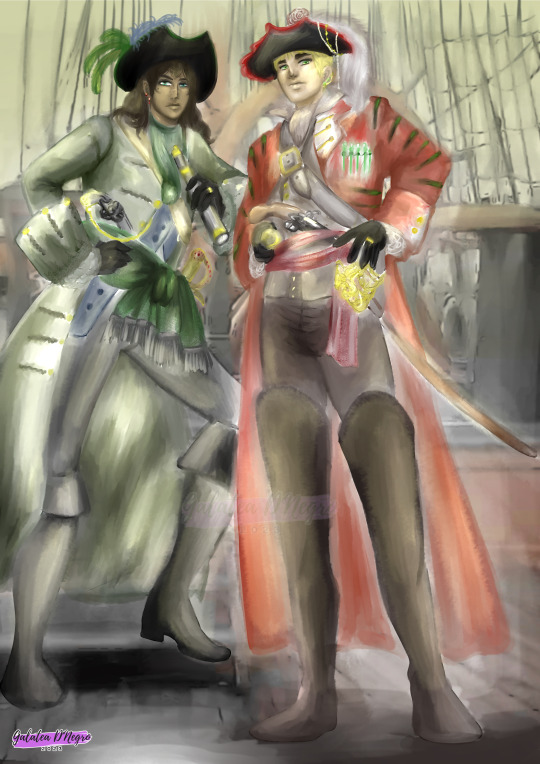
Aye aye, my Captain!
This is the final product of a whole story @greengreekeyes25 and myself did during all these months. We did so many Pirates AU's by now, I think all that energy and ideas deserve a good final tribute. And this is mine (the wip is here if you are curious.)
I wanted to take a break of commissions and to practice more this "realistic painting" style. By the way, they were based on rl pirates, the poses are from two anonimous individuals and they were perfect for each one's attitude.
Hope you like it!~
Headcanons (because I studied a lot for the roleplaying and for this) and closeups behind the cut~
They've got details sakjdnskjda.


About the story:
Arthur (James) Kirkland is called the Tiger of The Seven Oceans, because he's a ferocious, scared and invincible captain, very well respected in the pirate community. The nickname came because when they were younger, he made a bet with his twins siblings (the Irelands) about each victory for them would be marked on his body as a tattoo. The result is, in the end, he fulled his shoulders and arms, so his older brother (Scott) told him he looked like a malasian tiger.
Pirates had their vanity; when they were immotalized in paitings and portraits they used their best clothing and weapons. This composition is inspired in real pirate paintings, so it is a mix of the fandom looking and real ones. The green stripes in the red coat represent the marks of the tiger (in green because they're tiny emeralds). They're the same shape as in his body. And the green pins in the chest are each captain he decapitated.
Colors were chosen for Greek, and they make a good contrast about energies and the elements each one have; Port is more an explorer and teacher, apparently calmer, and England is more aggresive and direct. The pose and the way of looking mark that too.
We had a matelotage, a legal marriage between pirates - that's why the gold rings. And this is the only historical register of how they looked; this was painted the same day of the famous "weeding", in which there were present remarkable pirates such as Francis (Corsaire l' Terror of Le Havre ) , Sadiq and Yao ("The Kings of the East" / muluk alsharq / Dōngfāng zhī wáng ) and Antonio ("El León de la Iberia"). Big good party.
How the couple met? What happened with them? it's a mistery. You can find them in a museum )?
It's the said that a lot of pirates tought that love was no real, and it was all a big performance to ensure their names; but others were there and testifed the union: two lines remembered in the chronicles of that time: "My heart is in your hands now, love of mine." " Then I will keep it with me forever." ... But maybe it's a tale.
The couple and their love was legendary, beyond their pirate actions. They were the best example of partners, friends and lovers. Arthur was known as a very harsh person, brutal and mean; but with Gabriel he was the kindest lad in the sea.
#hetalia#aph portugal#aph england#engport#porteng#piratalia#aupirates#pirates au#hwsengland#hws portugal#hws england#these old ladies of the sea filled our hearts#so yeah those sassy poses are from real sassy pirates
36 notes
·
View notes
Text
Why is it that when taking about certain female historical figures, people make a point to bring up if they were really ugly.
Because I’ve seen the paitings of many historical men and they were the ugliest pieces of shit I’ve ever seen, but no brings that up when talking about them.
1 note
·
View note
Quote
Write about a dream you had recently, recording as much detail as you
can remember. After you’re done writing, use a highlighter to color each word or phrase that feels particularly significant. On a fresh sheet of paper, transfer each highlighted word or phrase leaving space after each to write down the symbology or personal significance. Some things to consider: Does it have personal historical meaning? Is it a play on words or synonym? Does it elicit a particular emotion? Is there a color or texture you associate with it? Write as much as you can; one thought will lead to another. Go back to the beginning and circle words that strike an emotional connection.
Now write a poem using the words you have circled. Feel free to add to
and rearrange the words as needed.
Using your poem as a guide, draw and then paint your dreamscape. Pick a paint palette that reflects the mood of your dream world. The color you choose for the underpainting will represent the undertone of the dream. Using pencil and paint, recreate this world. Notice any feelings or thoughts that come up while you paint and, when you’re finished, record them in your journal. Glue or tape your poem to the back of your painting.
Kendrick, K., Layered impressions. A poetic approach to mixed-media paiting. Cincinnati. North Light Books. 2011. p. 42
#sleep#dreams#dreaming#dreamwork#dream therapy#dream analysis#dreamology#dream meanings#dream interpretation#the science of dreams#Inside Dreams Blog
0 notes
Text
DRAFTS: ...
A DETAILED DESCRIPTION OF HER APPEARANCE.
SYMBOLISM: FIRE.
CLASSICAL PAITINGS / SCENES.
PARALLELS: HISTORICAL FIGURES (AND EXPLANATIONS)
0 notes
Text
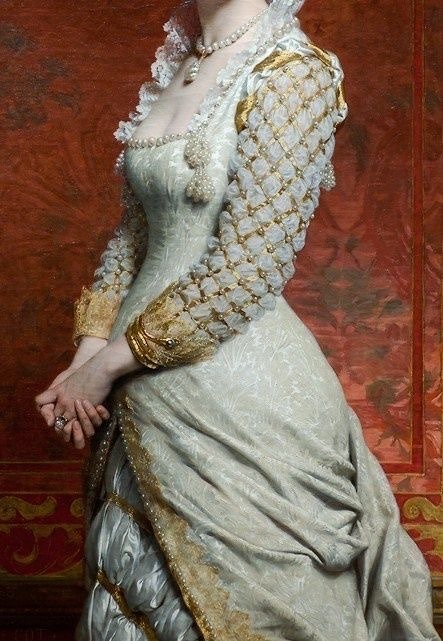

3 notes
·
View notes
Photo
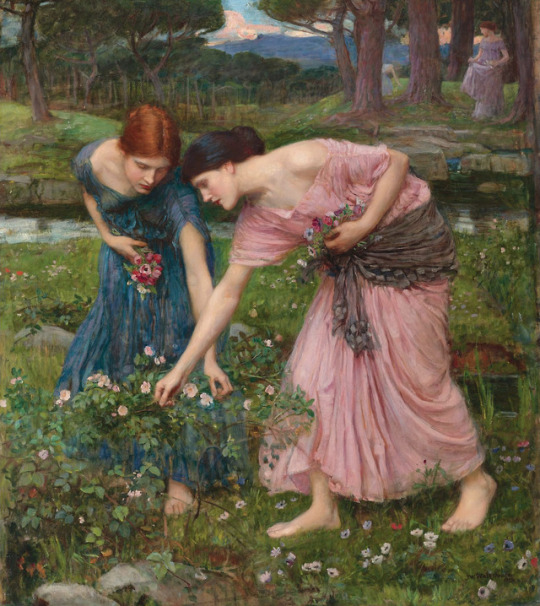



"Gather Ye Rosebuds While Ye May" by John William Waterhouse (1849 - 1917), 1909
149 notes
·
View notes
Text
Ekphrasis in The Danton Case, Thermidor, and their adaptations
Ekphrasis is invoking a piece of visual media into a literary piece. It can be done for a variety of reasons, from entirely pragmatic (mostly grounding the literature in reality - if the invoked piece is a real piece of art, one you could find in a museum, for example) or more poetic (drawing some symbolic meaning between the piece of art and the idea behind the text).
In Przybyszewska's plays ekphrasis is nonexistent, at least on the foreground. I don't recall any clearly established visual, given to the readers by the original author. It's not weird in any way - how many pieces of medai do you recall which refrain from its sophisticated and additional piece of subtext and iformation? Hundreds, probably. The only other artistic thing that she has weaved into her plays is La Marseillaise, which is invoked twice in The Danton Case. There are also three book references to Othello, Orlando furioso and this one book Robespierre summarizes to Saint-Just when he's talking about hatred (but of which I have no idea if it's a real one - it probably is - or not). Other than that - nothing, plus the books count only a little, forekpfrasis should be, as I said, visual in nature.
Of course, the historical aspect of her works is what grounds them in our reality, and so cleverly, too (seeing as they're not really historical plays in any way or form, but manage to fool most anybody). And thanks to her extensive stage directions, we have no need of any additional element helping us visualize the scenes, for she does it perfectly enough on her own.
However, seein as these are plays calls for a mirror ekpfrastic effect and thus theatrical and cinematographical adapations are born. And they, on the other hand, have a potential to be filled to the brim with visual refernces. Here I would like to have a look at a few, which are taken from one of the most well known staging and the famous Wajda movie (plus some). In no particular order, there goes:

This is the very first scene of a controversial theatre adaptation of The Danton Case. Instead on portraying Robespierre as a firm leader, who only in the very end collapsed temporarily under the huge responsibility he now had to bear, the director decided to portray him as someone physically weak, not in the sense Danton meant when he called him a weakling, but in the sense of somebody who already bears so much responsibility, pain, physical ailments, doubts and whatnot. Just: everything, everythin a human could possible deal with, he deals with, and has to do so in a way that doesn't make people suspiscious about his "shortcomings". There is a interesting parallel between him and Saint-Just, whose upright and unbreakeable character is symbolised by a neck braces, something which people wear after a spine endangering accidents - and incidentally, wasn't it Saint-Just who accused Robespierre of "breaking his spine"? But not in this adaptation, oh no - here their very last scene is cut extremely short and they recite the last few sentences along with some Thermidor lines as two floating heads, a vision into the future which awaits them.
Enough about Saint-Just, though, let's focus on Robespierre and Marat. I must admit I know next to nothing about him, only what some passage here and there in this or that historical study might tell me, but I know, as does everybody, that he was known as L'ami du Peuple, which is why of the reasons, I think, why the director took this image and transposed it onto Robespierre: to make him even more likeable, to show for the umpteenth time that it is Robespierre whom we should cheer on and whom we should feel sorry for. This might also be a parallel between their both's tarnished health, their premature deaths and - last but not least - the role of an icon of the Rvolution both of them play in nowadays' audience's minds. You don't have to study history to knowwho Robespierre was, you don't have to study art to know this painting. Even if you don't agree with some more in-depth explanation of linking this person to this painting, it is a good opening image. It captures our attention in a good way.
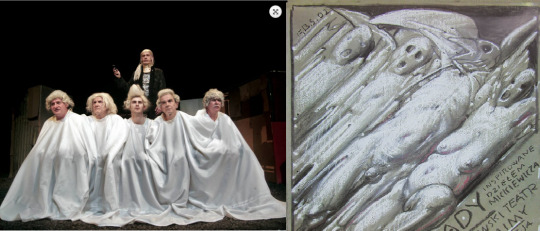
I had mention Saint-Just and there he is, in the background of the picture, symbolically assisting Danton and his clique in their last moments. Instead of shwoign them in torn shirts, the director went into another direction altogether and enshrouded them in white sheets from heads to toes, making them all look like very stereotypical ghosts, whom they will all become in just a couple of moments.
In Polish culture, the first thing that comes to mind when talking about ghosts is Dziady, an old slavic tradition that is now replaced with the Catholic All Souls Eve. Dziady is no longer, apart from perhaps some small minorities who still practice old pagan faiths, but as a ritual, they are immortalised in a play by Adam Mickiewicz, undoubtedly the greatest Polish poet ever. Everybody know this play, some scens - by heart, and they were and are being staged pretty much constantly from one point on. Needless to say, they inspire a lot of art, and I decided to show this very fmous poster by the most famous Polish poster designer, Franciszek Starowieyski…

…who is important in this case, because he played David in Wajda's movie.
Not many people know - because his other carreer overshadowed by a lot his first one - that Wajda was a painter. Who actually hated his art, some of his pieces are in the national museum of contemporary art in Łódź alongside stars such as Władysław Strzemiński (the hero of Wajda's very last movie), which is a fact he absolutely detested. I dont know, nor do I care, why was that, because what matters is his previous education as an artist at the very least helped him not only to envision the visuals of the movie, but also acquainted him with great works of art. On which he could model this or that setup. I think it's a nice little detail he catsed Starowieyski as David, a real painter acting as another real painter, it adds a layer of reality onto the movie, and presumably makes for a more natural acting in the few scenes he was in his studio (I also think they look alike).
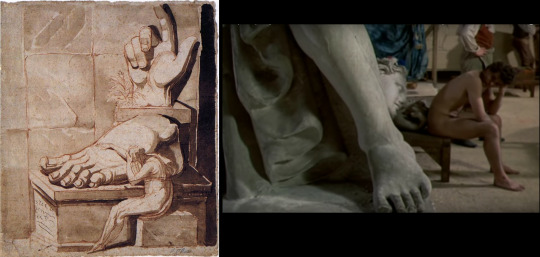
Speaking of David's studio, I once stumbled upon a lecture which drew parallels between some scenes in the movie and some paitings, which was mostly focused on character and costume design, and truth be told didn't contribute much to the overall watching experience of Danton. However, I must admit the lecturer had a very good eye in this one particular case, in which he pointed out that this quick shot in David's studio pretty obviously invokes the Fussli's The Artist's Despair Before The Grandeur Of Ancient Ruins. I don't think it's a coincidence (or at the very least, would be funny if it were) this shot is shown during the scene where Robespierre starts to grasp at desperate measures to save the country/save his own face in the trial. It is an artist's despair, only artist of a different kind. And it is a despair when being faced with a (possible) ruin of something great, even if its greatness is not yet formed, as opposed to the greatness passed.
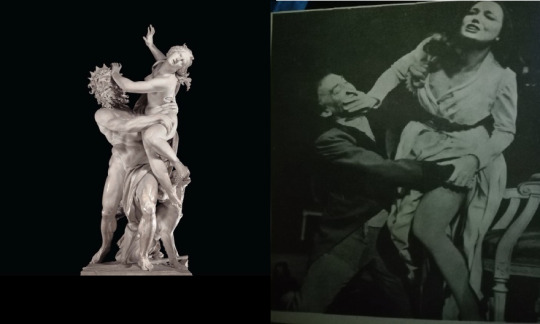
The very last example I was able to think of was this photo I found of The Danton Case from 1975. It is one of those old, very classical (I presume) adaptations, which are mostly filled to the brim with riddiculosly attractive people and very often deliberately drew from other sources of artistry, like the one pictured above. No matter what the real relationship between Louise Danton and her husband was, in the play it is portrayed as something atrocious, and I cringe whenever directors try to make it something else without good reasons for doing so, so I am very glad in the past at least they stuck with classicaly depicted acts of violation against women, not because it is a violation, but because in the classical stories (like the myth of Persephone shown in the sculpture above) the woman will usually get her revenge. Just like Przybyszewska's Louison did.
Thank you for bearing with me until the end, and if you have any other examples of this come to your mind, I compel you to share them with me!
List of pieces of art in the order of their appearance:
Jacques-Louis David, The Death of Marat
Franciszek Starowieyski, Dziady
Jacques-Louis David, Self-portrait
Heinrich Fussli, The Artist's Despair Before The Grandeur Of Ancient Ruins
Gianlorenzo Bernini, The Rape Of Persephone
#Stanisława Przybyszewska#stanislawa przybyszewska#andrzej wajda#the danton case#sprawa dantona#thermidor#jan klata#jerzy krassowski#jacques louis david#heinrich fussli#gianlorenzo bernini#art#ekphrasis#franciszek starowieyski#painting#sculpture#ekfraza#rzeźba#sztuka#Ekphrasis is my current hobby so I had to pull this together
38 notes
·
View notes
Photo
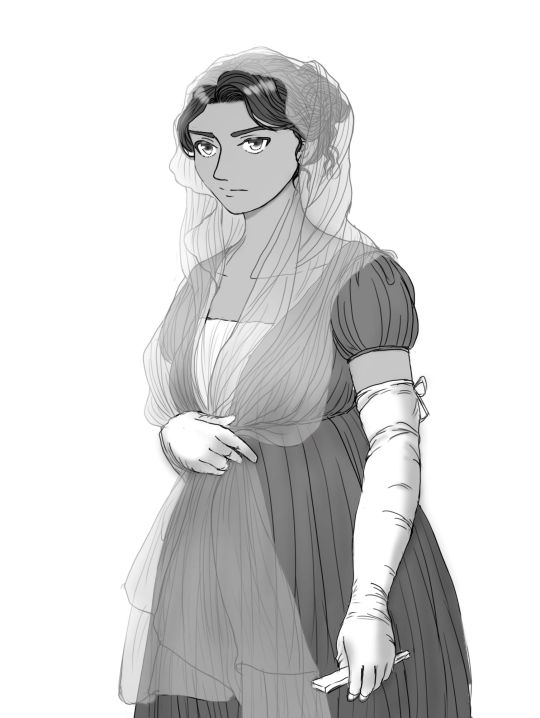
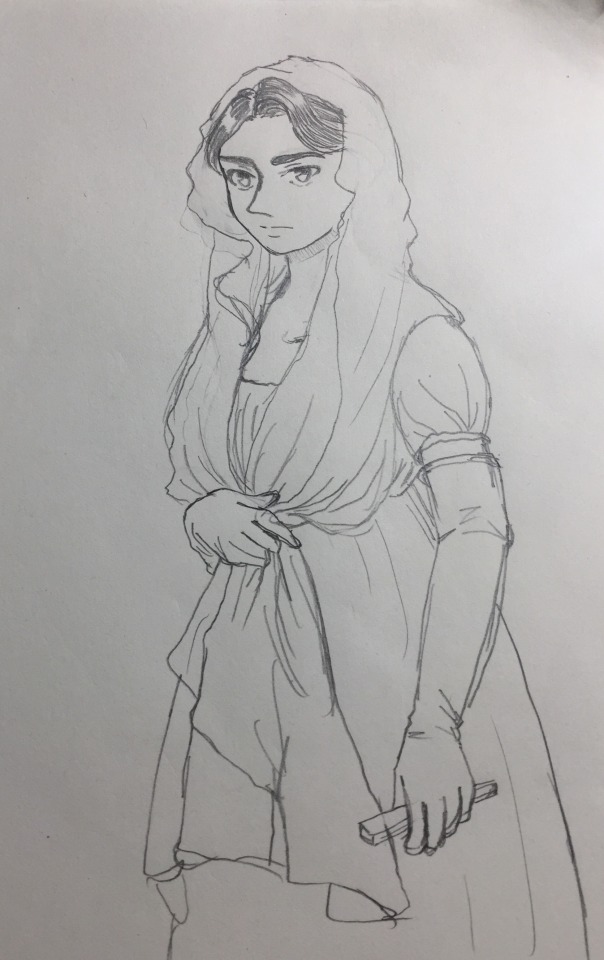
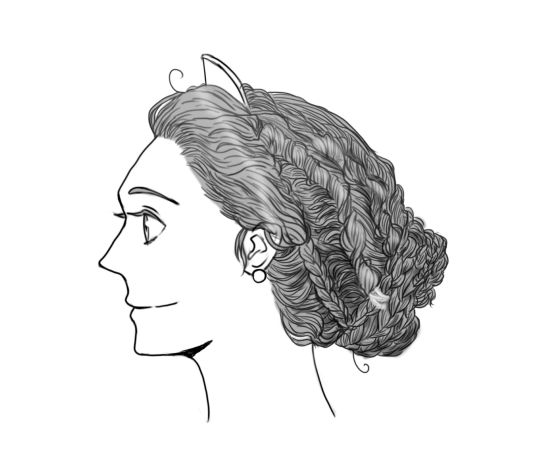
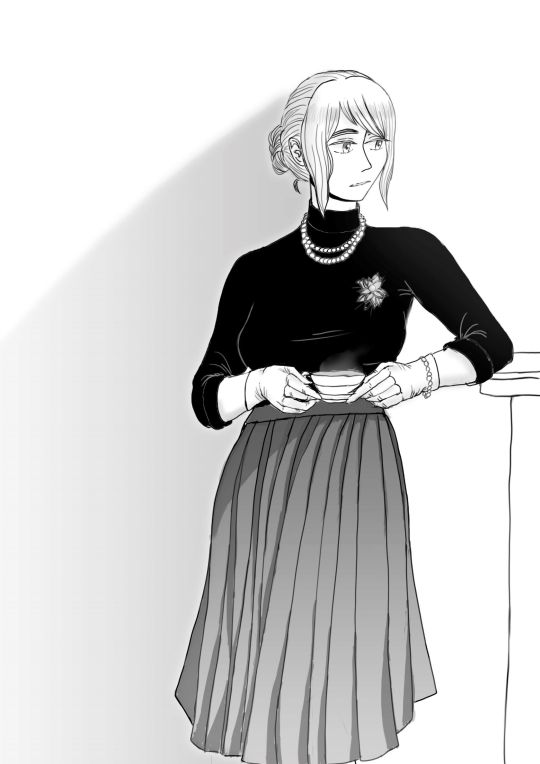

I have not post anything for quite a while,because art block hit me hard again _(:з」∠)_here are some doodles I struggle to make recently
P1 is 1810s Mexico,a redraw of a doodles ages ago(P2), so ages ago that back then I didn’t have a proper drawing board and had no idea how to pait on computer. The guesture and costume are both from a historical potrait.1810s is a pretty important period for Mexico, when she went to war with Spain to gain independent. I really want to capture the drama and tension behind it,maybe I will draw a short comic later when I have energy _(:з」∠)_
P3 is nyo ancient rome in historical hairstyle.It is also side face practice since I still have trouble drawing side face.And how could I draw good ship interaction when I have trouble drawing side face?!
P4 is mordern nyo england.I use photo as refercence for the gesture.One of my headcanons is that Ms england kind of have a boomer vintage vibe at mordern time,since she has lived for thousands years to this point. In other words, she sometimes dresses,acts and feels like an older,middle age lady,which confuses people don’t know who she is,since her appearance is still quite young.
P5 is just a random doodle of nyo england. I feel like my drawing style changes to korean style slightly because I have watched tons of korean comics recently _(:з」∠)_
#APH#APH England#nyo england#APH Nyo England#aph rome#aph ancient rome#aph mexico#nyotalia#historical hetalia#aph nyo mexico
63 notes
·
View notes
Note
5, 7, 10 xx :-)
5. favourite song in your native language?
NGHHHHHHHH, this is hard. Well, shit, I gotta say... to sing my heart out, while violently dancing in a car with my friends? Italian cartoon openings are THE BEST. We have crazy good dubbing actors and especially for cartoons we have dedicated artists to create openings.... and let me tell you, it’s quite amazing how they do them? Bc italian openings are basically poetry presentation for the cartoon/anime (so a kid, only listening to the song, can get the plot and watch whatever episode it’s airing) but at the same time they got to be catchy and represent the ‘mood’ of the anime/cartoon. I’m not kidding but some of those musicians are doing CONCERTS TO THIS DAY in which they play those openings for crowds whose age vary from 10-35 years old!
Okay, serious answer now: Il testamento di Tito by Fabrizio De Andrè. No explanation bc I can’t do justice to him or to the song.
7. three words from your native language that you like the most?
.... these asks are more difficult than I thought, shit. I study italian literature. I will go with something that has no direct translation: bho, vabbè, pucciare.
(The last one is not italian italian, it’s italianized dialect from my region but TO THIS DAY, i’m really upset that it’s not an italian word???? How do i express pucciare without saying pucciare? It’s not intingere, that you do with a brush, and it’s not the same of inzuppare or bagnare, bc it highlights the wetness!)
I am unraveling, leave me alone.
9. which of your neighbouring countries would you like to visit most/know best?
Well, that’s two different questions! The country that I’d like to visit the most atm? France... or Scotland (bc one of my dearest friend is there and I cant wait to explore it with her). Ah, I’m too much of an european, so to me every european country it’s a a neighbouring country.
The country that I know best... well, from a historical point of view, seeing our schooling system, i know shit ton abt UK. But if you talk about first hand experience, I gotta say Spain. I spent 3 weeks traveling in the south with my parents when I was 14, I was so happy to see Cervantes’ statue (bc I learned spanish in middle school and we read Don Quijote de la Mancha, I still have a tshirt with the first page of the book written on it in spanish, and my pencil case has Picasso’s paiting of Don Quijote on it) + for my viaggio di maturità (too long to explain and i dont think many here care abt it dajhdsa sorry, another italian thing) I spent 10 days in Barcelona with one of my best friend. Spain is a really culturally rich country and damn, I wish I could go back!! It’s stunning, choke full of good art everywhere! Which, for my italian ass? An absolute requirement.
#one day im gonna shut up#but CLEARLY not today#wanna?#ask#you choose some hard question dude!!! ahshsusis i love it#tysm :))))#jinn out
4 notes
·
View notes
Text
♡♡♡♡♡♡♡♡♡♡♡♡♡♡♡♡♡♡♡♡♡♡
Hi there! I'm searching for new blogs to follow!
Interact with me (rb,like) if:
speaks portuguese, english or spanish
Anti-Terf, Anti-MAP or NoMAP
Have a variety of interests
Isn't a radical of any kind
Doesn't post animal cruelty or NSFW
Isn't a fvcking creep (( I'm a minor, according to my local legislation ))
and if you are into:
Vintage
Historical
Political
2010's Cartoons (Steven Universe, Adventure Time, Regular Show, Gravity Falls...) and their fandoms
Positivity and Mental Health Awareness
LGBTQ+ pride
Animal Crossing, The Sims or any casual game
Witchcraft, Cottagecore, Softcore
Grunge
Netflix
Anime
Classical TV Series
Any kind of Art (paiting)
Wholesome memes or news
Thanks for the attention!
♡♡♡♡♡♡♡♡♡♡♡♡♡♡♡♡♡♡♡♡♡♡
#personal#my dashboard is dead#my post#me#brazilian#idk#vintage aesthetic#dark aesthetic#cottagecore#fandom#su#at#mlp#political meme#positivity#wholesome#historical#lgbtq community#anime#aestethic#genderfluid#grunge#victorian#victorian era#middle ages#animal crossing pocket#studio ghibli#the sims#2020#2010
7 notes
·
View notes
Text
The Unpopular Opinion Book Questionaire
Before I start, credit where credit is due: I copied the questions and format of this post from @resist-the-fear’s post and this wordpress post, because I couldn’t figure out how to add my answers into the original post without messing up all formatting. And I’m really sorry if this upsets anybody, but the idea is cool and it’d be a shame not to continue it on tumblr.
So, here we go...
1. A Popular Book or series that you didn’t like.

1) Feels like the Twilight Saga would be the obvious answer (and it IS), but I’m gonna go for pretty much all of Dan Bown’s novels and I’m gonna explain my dislike with The DaVinci Code
This novel actually angered me so much that I wrote my master’s thesis on how Brown deliberately mislead the majority of his readers into mistaking his fiction for actual facts in order to sell more books.
The gist is, any and all art historic descriptions and information given within the book are fully fictional. That includes a page of “facts” (labeled as such) preceding the novel itself (which doesn’t contain any actual facts at all) and a note underneath stating that all descriptions of paitings were accurate. Spoiler alert: They’re not. I majored art history in school and did a lot of research, but, honestly, anybody who’s interested in art history and knows the very very basics about the renaissance and other time periods can easily disprove all of the novel’s supposedly accurate art descriptions.
And, to be truthful, I have to admit that Brown is really fucking good at fiction. He’s also really good at writing his fiction around and over existing art historic knowledge and twisting it without making it too obvious for careless readers. That’s kinda cool. And I get that disguising fiction as fact isn’t a new trend. I mean... Defoe did when he falsely claimed that Robinson Cruseo was a factual report of a true event, because the readership of his time period wasn’t familiar with adventure fiction. But what really annoyed me was 1) how many readers actually believed Brown to have uncovered some genuine conspiracy and 2) that Brown kept feeding into the delusion of those fans again and again through comments in interviews and webpages, even though he fully knew it’s all fiction, because he himself made it up.
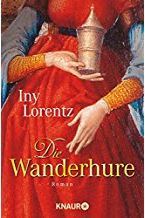
2) And then there’s the Wanderhure series, written by a German writing couple under the pseudonym Iny Lorentz. I’m not sure if this has been translated into English, but it’s been highly popular in Germany and several other countries (won some awards and was made into a series of TV movies and whatnot). It is, quite honestly THE WORST BOOK I HAVE EVER READ IN MY WHOLE LIFE.
The first novel was recommended to me by relatives because parts of it take place in a city that I have lived in for quite some time, and it’s a historical fiction based on a medieval poem. The premiss of the novel is great: during the middle ages, a young and respected girl gets accused to have sinned by some townspeople and nobody believes her to be innocent, as she is just a girl. She gets cast out of her city and home, left with no other choice than to become a traveling whore if she wants to survive. She ends up becoming quite successful in her profession (in the sense that she has many high ranking clients from both church and state who pay her with lots of money and other favors) and returns to the city that cast her out long ago to have a huge effect on politics and religion.
The story was quite intriguing to me, both due to the interesting plotline as well as the reference to the city I live in. HOWEVER, it is horribly written. All characters, especially the protagonist, are unbelievably flat. There is no character development whatsoever, even though the story offers plenty of chances to find it. I read through the book because of the locations... houses that actually still exist, that I have been in, Gateways that i’ve walked through, roads that I’ve travelled on. Those are very well described. It’s easy to figure out each and every step the characters take on a map and that’s really cool. But the plotline was destroyed by less than mediocre characterization and simple, unimpressive language. Every time a character is supposed to feel something, the sentence literally goes, “She felt xyz” - and that’s as descriptive as it gets. There’s no atmosphere created and not an ounce of fluidity in the sentence structure. The whole narration is as dry as brick and the story reads like a two dimensional still drawing of a 3D rollercoaster ride.
2. A Popular Book or series that every one else seems to hate but you love.

I honestly don’t think that there’s any book series that EVERYBODY hates. And I do think that all the books I love, are actually pretty popular. Buuuuut...
I’ve seen the Mortal Instruments series getting a lot of hate on tumblr. And I fully understand why Cassandra Clare isn’t everybody’s favorite author. I don’t like her methods and procedure at all either. But, I have to say that I do like the basic plotline of the Mortal Instruments. I’ve only read the first three novels, and I have no clue what happens afterwards. And there’s a lot to be criticized, be it Clare “copying” existing dialogues, or some really flat and ... well, just plain naive characters. BUT the plot itself is cool. So, I felt positively entertained and liked it. Love would be a bit of a strong term, though, I think.
3. A Love Triangle where the main character ended up with the person you did NOT want them to end up with (warn ppl for spoilers) OR an OTP that you don’t like.

Not giving any spoilers, but the Demon’s Lexicon Trilogy. I really, really disliked the reveal of an actual pairing in the third novel. It didn’t make sense to me, and I wasn’t reading for romance to begin with. It kind of cheapened the story because the love interest side story suddenly got A LOT of attention that it didn’t before and that shifted the focal point of the overall plotline. (Loved the first book, really liked the second, couldn’t care less for the third, tbh)
4. A popular book Genre that you hardly reach for.
It’s either crime fiction or esoteric non-fiction.
I’m actually into a lot of different genres: almost all types of fiction (YA, dystopian, sci-fi, political, thriller, mystery, adventure, horror, fantasy etc.), also children’s books, travel books, hobby and craft books, satires, other humorous books, biographies/autobiographies, educational books, historical books both fiction and non-fiction...
Doesn’t matter, but crime fiction (as long as it doesn’t contain anything else) is just so boring to me. Also, it feels to me as if most crime fiction heroes solve those crimes with A LOT more lucky coincidences than I would hope actual crime fighters depend on.
And esoteric books are just completely outside my personal interests. Either the stuff described in those books feels like fiction to me while being sold as non-fiction, or it’s stuff that I feel should not be aquired through books but personal encounters and explorations.
5. A popular or beloved character that you do not like.
Definitely Clary Fray from the Mortal Instruments. Man, she is soooooo slow on the uptake and so naive in so many ways. And she’s also kind of a horrible Mary Sue, not just because of her name... (I mean, really? Clary, Ms Clare? 😔) But also because of how she is so awesomely good at everything and how she always thinks of the perfect solutions for everything when nobody else does. Kinda... very little room for character development. But, then again, who needs that, right?
6. A popular author that you can’t seem to get into.



Aside from Dan Brown? Here’s my unholy trinity...
1) Stephenie Meyer (yeah, the Twilight one) - I was actually sent an e-book copy of Twilight right before it became such a huge success. I started reading it, because my friend recommended it and praised it so highly. But, I couldn’t make it past a couple dozen pages. The writing style is just so bad, I couldn’t continue. The characters were so flat, I lost any and all interest in what was going to happen. And the story wasn’t all that intriguing either, especially because it was loaded with antiquated world views, especially Bella’s character and what was deemed right for her to do was just... WOW, it was just so unbelievably bad, lol. I was so surprised that it actually ended up being successful.
2) E.L.James (the 50 Shades one) - For years, I genuinely believed that it was impossible to write worse than Meyer. Boy, was I wrong. I tried several times to read more than ten pages of 50 Shades of Grey, and I failed every single time. It’s not just a bad story, I’ve seen children’s books for toddlers that have a more interesting sentence structure than what she comes up with for an adult audience. Her language is so dull and non-descriptive that even the supposedly racy sexy bits read like a phone book to me. Honestly, I DON’T GET WHY anybody ever had any interest in this book series. The language is unspeakably poor, the plot takes all the wrong turns it could possibly take, the “research” done before writing the book... I don’t even know where that load of complete misinformation could possibly come from.
3) Iny Lorentz (the writing couple I mentioned above: Elmar Wohlrath and Iny Klocke) - Just bad, bad, bad writing. No concept of character development, fiction asthetically written like non-fiction, no use of language to create atmosphere or convey emotions. They write neutral snoozefests. And... I can’t bring myself to write any more on them.
7. A popular book trope that you’re tired of seeing. (examples “lost princess”, corrupt ruler, love triangles, etc.)
Mary Sues and Gary Stues. But Love Triangles are a very hot contender.
8. A popular series that you have no interest in reading.
All the different Shades, lol.
9. The saying goes “The book is always better than the movie”, but what movie or T.V. show adaptation do you prefer more than the book?

Definitely Stand By Me which is Stephen King’s The Body. That movie is about as great as that story could have possibly been when put onto the screen. The actors were so perfectly cast, the cinematography, costumes and set design really captured the time period, atmosphere and geography, and the facial expressions portrayed all the right emotions beautifully.
Also, I have to say, out of all of King’s movie adaptations, and while neither The Body nor Stand By Me are categorized as horror, the scene where you can see the dead boy’s face is one of the scariest, most horrific moments I can think of in a film ever. It gave me nightmares when I first saw it, and still, to this day, I have to close my eyes when that scene comes up. And the cool thing is, it’s not meant to be specifically horrifying, or gory or scary. But the simplicity of the sudden glimpse into dead eyes, to me, is scarier than any monster I could imagine and does King’s reputation more than justice.
2 notes
·
View notes
Text
Recycle - Light Paiting Technique
Light painting, painting with light, light drawing, or light art performance photography are terms that describe photographic techniques of moving a light source while taking a long exposure photograph, either to illuminate a subject or space, or to shine light at the camera to 'draw', or by moving the camera itself during exposure of light sources. Practiced since the 1880s, the technique is used for both scientific and artistic purposes, as well as in commercial photography.
Light painting also refers to a technique of image creation using light directly, such as with LEDs on a projective surface using the approach that a painter approaches a canvas.
Techniques
Light painting using handheld lights to selectively illuminate or colour parts of the subject or scene or to evenly light large architectural interiors has been used in professional photography since the 1930s as described by Leslie Walker and Ansel Adams. Light painting requires a slow shutter speed, usually at least a second in duration. Light painting can imitate characteristics of traditional painting; superimposition and transparency can easily be achieved by moving, adding or removing lights or subjects during or between exposures.
Projector light painting, by waving a white translucent flash diffuser in the light path of a portable projector, the continuous motion creates an invisible screen in the air for the projected image in the photo.
Light paintings can be created using a webcam. The painted image can already be seen while drawing by using a monitor or projector. Another technique is the projection of images on to irregular surfaces (such as faces or buildings), in effect "painting" them with light. A photograph or other fixed portrayal of the resulting image is then made.
Kinetic light painting is achieved by moving the camera and is the antithesis of traditional photography. At night, or in a dark room, the camera can be removed from the tripod and used like a paintbrush. For example, using the night sky as the canvas, the camera as the brush and artificially-lit cityscapes as the palette. Putting energy into moving the camera by stroking lights, making patterns and laying down backgrounds can create abstract artistic images.
There are five basic types of light painting or light drawing: Historically they have just been lumped into a category called light painting, there are subclasses of the different ways you can use a light recorder (aka camera) to make photographs of just light or adding subject matter into a light painting or light drawing. A distinction can be made between light painting and light drawings or subgroups of this type of work;
Picasso's classic light drawing with a penlight published in Life magazine circa the 1960s.
Light painting the subject in a totally dark room with a camera on a tripod, open the camera up and paint light onto the subject with a light source generally a small penlight.
Long exposure with a camera fixed on a tripod. Open the camera up and paint light into the camera - draw light into the camera - use a strobe to freeze the subject, or illuminate the scene with different light sources.
Ambient light and strobe. With handheld strobe separate from the camera - in your dark (night) environment - open hand held camera to create a low light expanded time image and set strobe off to freeze subject matter as most photographs do. The strobe is a very short blast of freezing light, and freezes intended subject.
Pure Light - Light a Painting (Abstract); With an arrangement of fixed lights in a dark room or studio and a handheld camera - open the handheld camera up and move through the lights painting the light into the camera sensors. Yields images of just light as an abstract design. The reverse can be done with a fixed camera on a tripod and moving lights. Both drawing and painting.
Tools for light painting
Before you start doing light painting, you’ll need to make sure you have the proper tools:
Camera – Any digital camera capable of manual settings (including Bulb mode).
Tripod – One of the most important tools to produce light paintings. In most cases, your shutter is going to be open for several minutes, and it is very important that your camera does not move during the exposure.
Shutter release – Either use a cable release or a remote shutter release to begin your exposure. If you don’t have either of these, use your camera’s self-timer function to initiate the shot. It is very important that you never touch your camera or tripod during the exposure.
Stopwatch – A stopwatch or some other way of timing your exposures is helpful, since most light-painting exposures will use Bulb mode.
Light source – Many different types of lights can be used for light painting. These light sources are your “brushes” and may include flashlights, torch lights, lasers, glow sticks, flashes, cell phones, and even candles. Just about anything that can produce light can be used for light painting. Note that different light sources will produce different colors of light. For example, an LED light source will produce a cooler (blue) colored light, while a halogen source will produce a much warmer (orange) colored light.
Color gels – Color gels can be used to alter the tint of your light and add color to your painting.
Camera settings
Now let’s take a look at the best camera settings for light painting:
Mode – Shoot in Manual mode, which allows you to set your shutter speed and aperture.
Image quality – Set your image quality to RAW, which allows you to capture as much information as possible. (This is not a necessity, but it is an important recommendation.)
White balance – If you want to balance out your artificial light source, choose either the Incandescent or Tungsten white balance setting. However, sometimes experimenting with other white balance settings can produce some interesting light effects. Daylight white balance is a good starting point if you want to maintain the original colors of your artificial light sources. Auto White Balance is not recommended.
ISO – Use a low ISO, such as 100.
F-stop or aperture – Stop down to f/8 or f/10, which allows you to get more depth of field and enables you to use a longer shutter speed.
Shutter speed – Set your shutter speed to Bulb mode (your final shutter speed will be determined by the amount of ambient light in the scene).
LCD brightness – Lower the brightness of your LCD preview, because the normal setting is too bright at night and will make your image look bright when it’s actually underexposed.
Histogram – Use your histogram to check your exposure. If the histogram skews heavily to the left, your image is going to be too dark.
Blinkies – Turn on your blinkies (a highlight warning) to help you determine if your highlights are exposed properly. It is perfectly acceptable for your brightest highlights to be slightly clipped if the rest of your image is properly exposed.
Image stabilization – Set this to Off. With your camera on a tripod, having image stabilization turned on can actually fool your camera or lens and cause blurring in your image.
Long exposure noise reduction – The recommended setting is Off. This can be set to On, but it will cause your exposure time to double (because the camera takes a second black exposure to help remove noise). If your camera is set to a reasonable ISO, the noise level will be low enough in most cases that in-camera noise reduction is unnecessary. Still, it is a good idea to check your noise levels in advance, and some older cameras may require this setting to be On to get acceptable noise levels.
0 notes
Text
Electrical Heating Stoves Market (covid-19 update) upcoming business reports on size, shares, stocks and many more | forecasting report 2026

Electrical Heating Stoves Market
The research report, labeled Global Electrical Heating Stoves Market Report 2025 provides a clear understanding of the subject. This report was collected using the primary and secondary research methodology. Both of these methods focus on working with accurate and meticulous statistics about market dynamics, historical events and the current market situation. Recent research statistics has allowed professionals to understand their ideas for market development.
This Press Release will help you to understand the Volume, growth with COVID19 Impact Analysis. Click HERE To get SAMPLE PDF (Including TOC, Table & Figures) at: https://introspectivemarketresearch.com/request/11979
Key Player Mentioned: Broseley Fires, Chesney, GLEN DIMPLEX, SEI, Buck Stove, Twin-Star International, Holly & Martin, Napoleon, Kent Fireplace, Faber, Adam, Jetmaster, Fuerjia, Rui Dressing Technology, Allen, BTB, Boge Technology, RICHEN, Saintec, Hubei Ruolin, Paite, Andong.
Product Segment Analysis: Built in, Free-Standing and others
Application Segment Analysis: Residential, Commercial.
Regional Segment Analysis: North America (U.S.; Canada; Mexico), Europe (Germany; U.K.; France; Italy; Russia; Spain etc.), Asia-Pacific (China; India; Japan; Southeast Asia etc.), South America (Brazil; Argentina etc.), Middle East & Africa (Saudi Arabia; South Africa etc.)
The report includes an executive summary, world economic outlook, and overview section that provide a consistent analysis of the Electrical Heating Stoves Market. In addition, reports in the market overview section describe SWOT and PESTLE analysis to provide a thorough analysis of the market and help you to take business decisions to achieve great success in this situation. The overview section details Porters' Five Force analysis, which helps to reveal possible scenarios in the market by disclosing competitive study related to the market.
With tables and figures that help to analyze the global Electrical Heating Stoves Market. The study provides key data on the current state of the industry and provides useful guidelines and directions for companies and individuals interested in the market.
Get Your Copy at a Discounted Rate!!! Limited Time Offer!!! :
https://introspectivemarketresearch.com/discount/11979
Target Audience of the Global Electrical Heating Stoves in Market Study:
• Key Consulting Companies & Advisors
• Large, medium-sized, and small enterprises
• Venture capitalists
• Value-Added Resellers
• Third-party knowledge providers
• Investment bankers
• Investors
Get Full Report Access at: https://introspectivemarketresearch.com/inquiry/11979
About Us:
Introspective Market Research is a visionary research company who is ready to assist their customer to flourish their business by offering strategies for gaining success. We sell market research reports received from other leading companies in the market research industry which offer in-depth and trustworthy information on different topics and sectors.
The IMR founded by the team of experts and experienced professionals in the industry. The team is focusing on offering the empirical data collected from experts that can be the base for the next few years. The Aim of the company is to offering reports from numerous sectors such as FMCG, technology, food beverages, media, chemical, and healthcare among others.
Contact Us:
Alden Brooks
3001 S King Drive,
Chicago, Illinois,
U.S.A 60616
Contact No: +1-773-382-1047
Email: [email protected]
0 notes
Text
[REVIEW] Menyemat di Semat Space (1)
"It’s incredibly useful both for us personally and on a historical level to keep a daily record of what goes on around us during difficult times," kata Ruth Franklin, seorang penulis. "Take a moment and make some notes about what's happening. Call it your Coronavirus diary, your plague journal, whatever. It's important. Later, you will want a record."
Seperti yang disarankan oleh banyak penulis dan ahli sejarah, kita sepatutnya punya catatan tentang kehidupan selama pandemi ini. Bukan cuma untuk kelegaan mental diri sendiri, tapi juga untuk catatan sejarah di kemudian hari. Nama saya Dina, dan ini salah satu catatan saya.
- - -
Jumat siang agak sore dikit, kami selaku Junior diajak "ngopi cantik-ganteng" yang berlokasi di Tasikmadu masuk kecamatan Lowokwaru.
Siang itu mendung tapi hawanya fanaass. Dan hampir jam 2 turun hujaaaan yang deraaass. Kami pikir, bakal nggak jadi nih. Eh alhamdulillah sampai sana malah kering kerontang.

Ketika masuk langsung kerasa nuansa homey-nya! Tempatnya nggak besar, tapi cukupan kok dan bikin betah. Terbagi jadi 2 ruangan. Atas dan bawah. Pantry dan toilet menempati ruang bawah. Kalau mau pesan juga langsung dari bawah aja ya kayaknya.
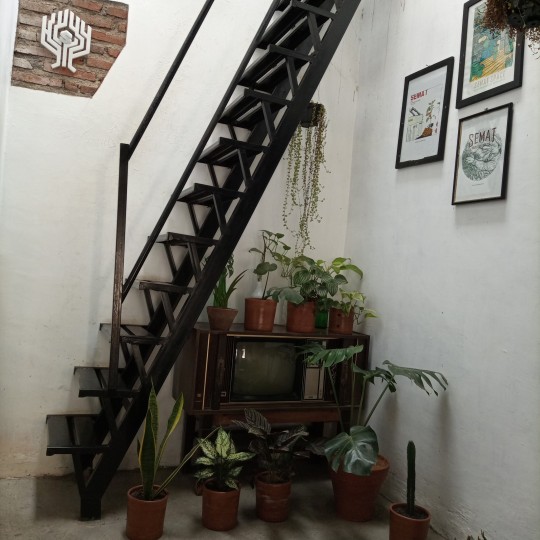
Untuk ke atas, ada tangga yang cukup curam (turunnya bikin skeriii) Hehe. Jadi kudu ati-ati banget.
Dan pas sampai di rooftopnya canciiiik loooh konsepnya. 😍 Yah maklum, udah boebo seneng liat yang ijo-ijo seger. Buat pepotoan juga seruuu.
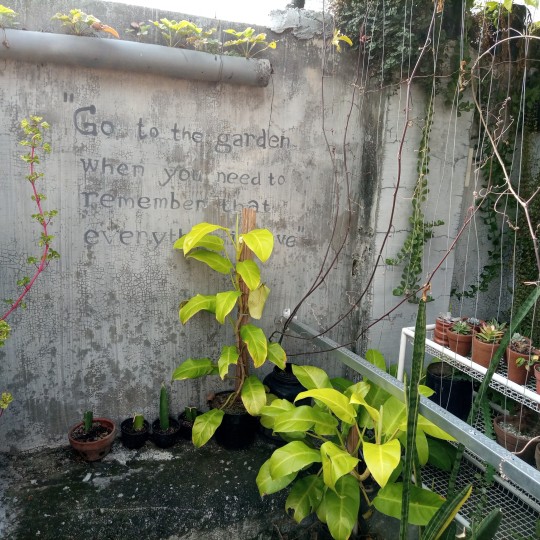
Kalau malam juga akan lebih terasa nuansa romantisnya. Tapi kalau malam, curiganya bakal masup angin deh kalau kelamaan di atas. Di atas sini, juga ada 2 spot yang aman karena ada atapnya.


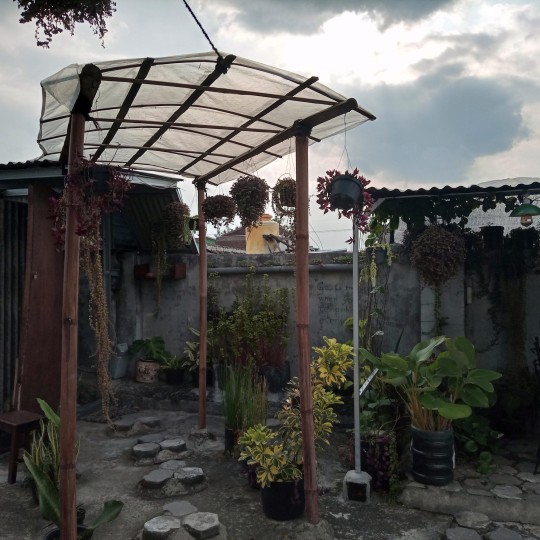
Menunya? Ini dari minumannya dulu ya. Karena nggak expert dan selalu bernasib jelek kalau minum kopi. Aku cari yang aman aja. :D


Pilihanku jatuh ke Affogato Matcha. Apa itu Affogato? Silahkan gugling. Pokoknya minumannya ini ada eskrimnya. Menurutku siiih enaaak. Tapi temen yang nggak suka matcha (teh hijau bubuk), katanya nggak enak. Sempet icip yang Affogato Mocha, rasanya pait. Duh, monmaap hamba memang lemah soal perkopian. T_T
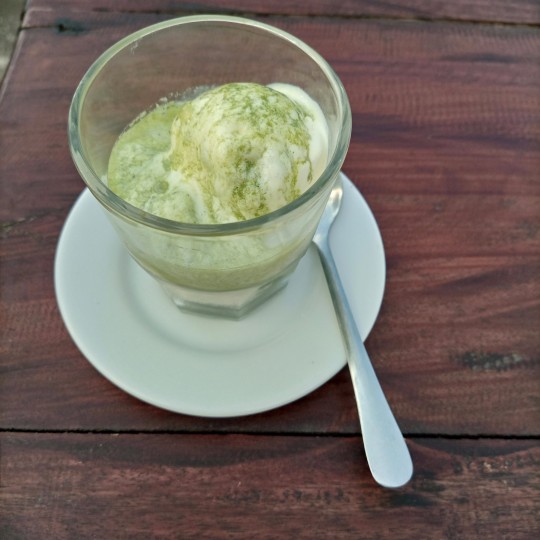
Untuk makanannya yang tersedia buat dicemil aja yaa, seperti kentang goreng sama donat. Karena aku termasuk tim yang seneng kentang goreng empuk, jadi menurutku kentangnya kegaringan dan terlalu kress. Wkwk. Kalau donat green teanya enak-enak aja sih. Tapi kalau disuruh nambah donatnya lagi, pasti kutaksangghuup. Kenyang! Kalau mau makan indomi di sini juga bisaaa pesen.
Nah. Lanjot! Ada beberapa spot yang lucu juga, tapi kumasukkan foto-fotonya di postingan selanjutnya yes. Aplot fotonya dibatesi dong sama Tumblr. :(
0 notes
Photo
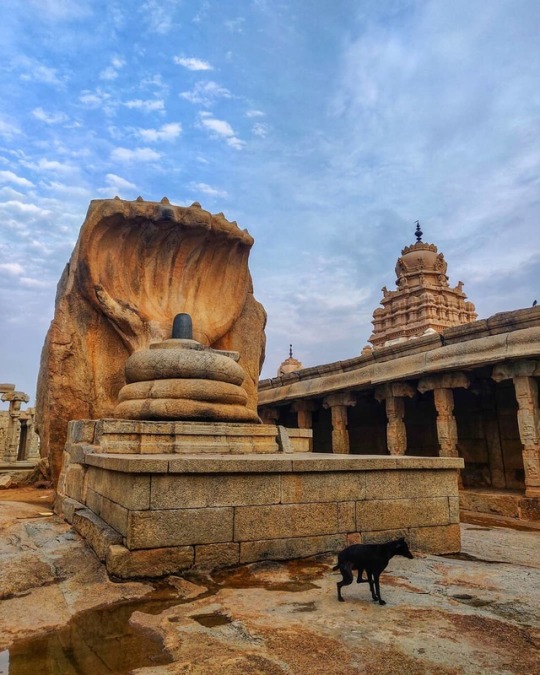
The naga linga sculpture is inside the #VeerahbadreswaraTemple at #Lepakshi in #AndhraPradesh, #Hindupur was supposed to have been carved out by a man in an hour. This is about 15 feet in hight very massive shiva linga sculpture with naga Prabhavali. Lepakshi is a small village located in the Anantapur District, in Andhra Pradesh. Lepakshi is very important historically and archaeologically. There are three shrines dedicated to Shiva, Vishnu and Virabhadra.The famous Veerabhadra temple, dedicated to Veerabhadra, is located here. Built by the brothers Viranna and Virupanna, the temple is a notable example of the Vijayanagar architectural style. It is famous for its sculptures, which were created by the artisans of Vijayanagara empire. Lepakshi is an ultimate testimony for Vishwakarma Brahmins who sculpted these temples. It is believed that noted Vishwakarma Amarashilpi Jakkanachari took part in the planning the architecture of these temples. There are many shila shasanas that the famous sculptors like Dakoju, Maroju took part in this temple sculpture. There are many specialities in this temple like rock chain, Vastu Purush, Padmini race Lady, Hanging Pillar , Durga Paadam, Lapakshi saree designs etc. On the walls of this temple, there are several stories like mahabhaaratha, ramayana etc are sculpted. Also on the roof there are so many beautiful paitings done by natural colour mixtures. One more famous spot in this temple is “Eyes of Viroopaakshanna”. As the history says, Due to king’s misunderstanding with this temple builder, king ordered to make him blind. Hearing this the builder plucked his own eyes and throw at this temple walls. Till date one can find those blood scars on that particular wall. https://www.instagram.com/p/B0S0NgXhHTe/?igshid=p77dq7qqlxfm
0 notes